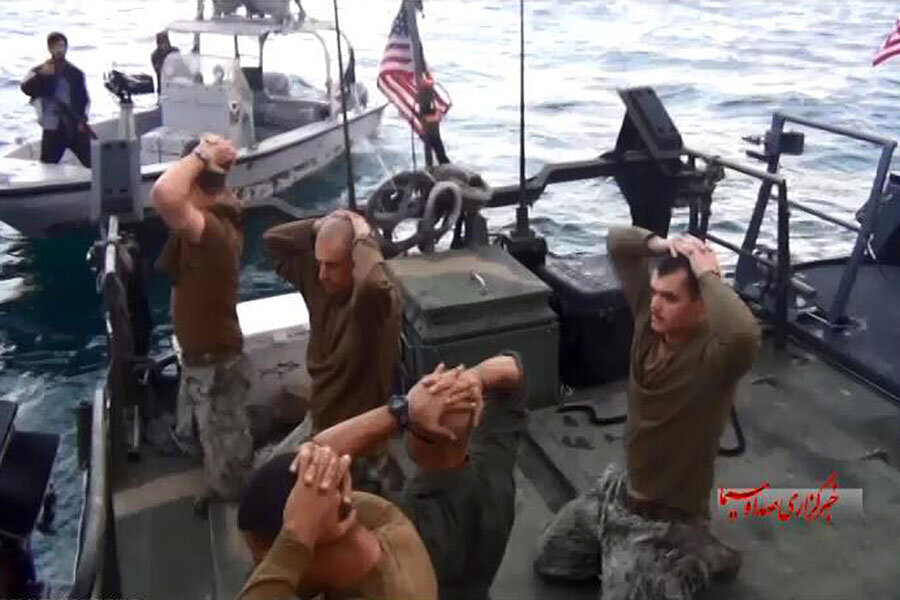Iran's capture of US sailors shows how it is acting better – and worse
| Washington
On Wednesday, Iran freed 10 American sailors. Just hours earlier, it had reported disabling its nuclear reactor in Arak – a key step in the landmark nuclear deal reached last summer with the United States.
At first glance, the two occurrences might seem unrelated. But both United States and Iranian officials are underscoring the role that the nuclear negotiations – and the related turn in US-Iran relations – played in the release of the sailors after only 24 hours in detention.
The “open channel” established between Secretary of State John Kerry and Iranian Foreign Minister Javad Zarif over the course of the nuclear talks “was very important in resolving this in a timely fashion,” said White House Chief of Staff Denis McDonough at a Monitor Breakfast Wednesday.
Critics say the administration has its analysis the wrong way around. They suggest the nuclear deal has emboldened Iran to indulge in bad behavior – like detaining the American sailors, whose two small boats apparently drifted into Iranian waters Tuesday.
But the incident does point to new pressures within Iran to resolve such flash points quickly. The disabling of the Arak reactor Wednesday paves the way to Iran receiving billions of dollars in sanctions relief under the nuclear deal. With those benefits so close, a tense standoff with the US over detained sailors could have been disastrous.
“We can all imagine how a similar situation might have played out three or four years ago,” Secretary Kerry said in a speech Wednesday at the National Defense University in Washington.
Under the nuclear deal, the US is to release some $100 billion in frozen Iranian assets once international nuclear inspectors verify that Iran has completed a number of steps. These include shipping most of the stockpile of enriched uranium out of the country and disabling the Arak plutonium-fueled reactor.
But on Wednesday, Kerry pointed to the new lines of lines of communication opened with the Iranians as crucial in defusing the naval incident.
“These are always situations that, as everybody knows, if not properly handled, can get out of control,” Kerry said. But years of dialogue with a country “we hadn’t talked to for 35 years” produced a better ending.
The nuclear deal was the product of President Obama’s promise in his 2009 inauguration address to extend a hand to adversaries who committed to unclenching their fists.
But critics say the detention of US sailors – not to mention the gratitude expressed by the administration for their release – demonstrate how Mr. Obama’s policy has weakened the US. Congressional Republicans view Obama’s approach as appeasement of an unrelentingly aggressive Iran.
“Since the Obama administration sealed the Iran nuclear deal, Tehran has been on a roll,” Ed Royce (R) of California said in a statement Wednesday as the House passed new Iran sanctions legislation. “It has accelerated its missile program, taken more Americans hostage, and stepped up its slaughter in Syria. The administration’s response? Silence.”
Other critics say the incident is a lamentable sign of America bowing before its adversaries.
“This humiliating incident illustrates why the US should not be doing deals with this kind of brutal, dictatorial regime that is the enemy of the US and the free world,” says Nile Gardiner, director of the Margaret Thatcher Center for Freedom at the Heritage Foundation in Washington. “It amply demonstrates the folly of the Obama administration’s nuclear deal with Iran.”
Obama administration officials can talk up the “dialogue” with Iranian officials, but “the photos of American sailors in detention and being taken in with their hands behind their head – photos Iran is gleefully distributing around the world – weaken America’s position on the world stage and frankly make America look like an easy target as well,” he adds.
The praise from US and Iranian officials about a new era of improved bilateral relations strikes Mr. Gardiner as hollow. The world is witnessing the failure of Obama’s broader policy of reaching out to America’s enemies, he says.
“What we saw so clearly before with the Russian reset we’re seeing again with Iran – that policies of engagement with adversaries simply don’t work,” he says. “A weak-kneed approach hasn’t solved anything – quite the opposite, it’s emboldened Iran.”






